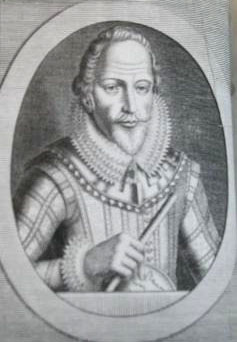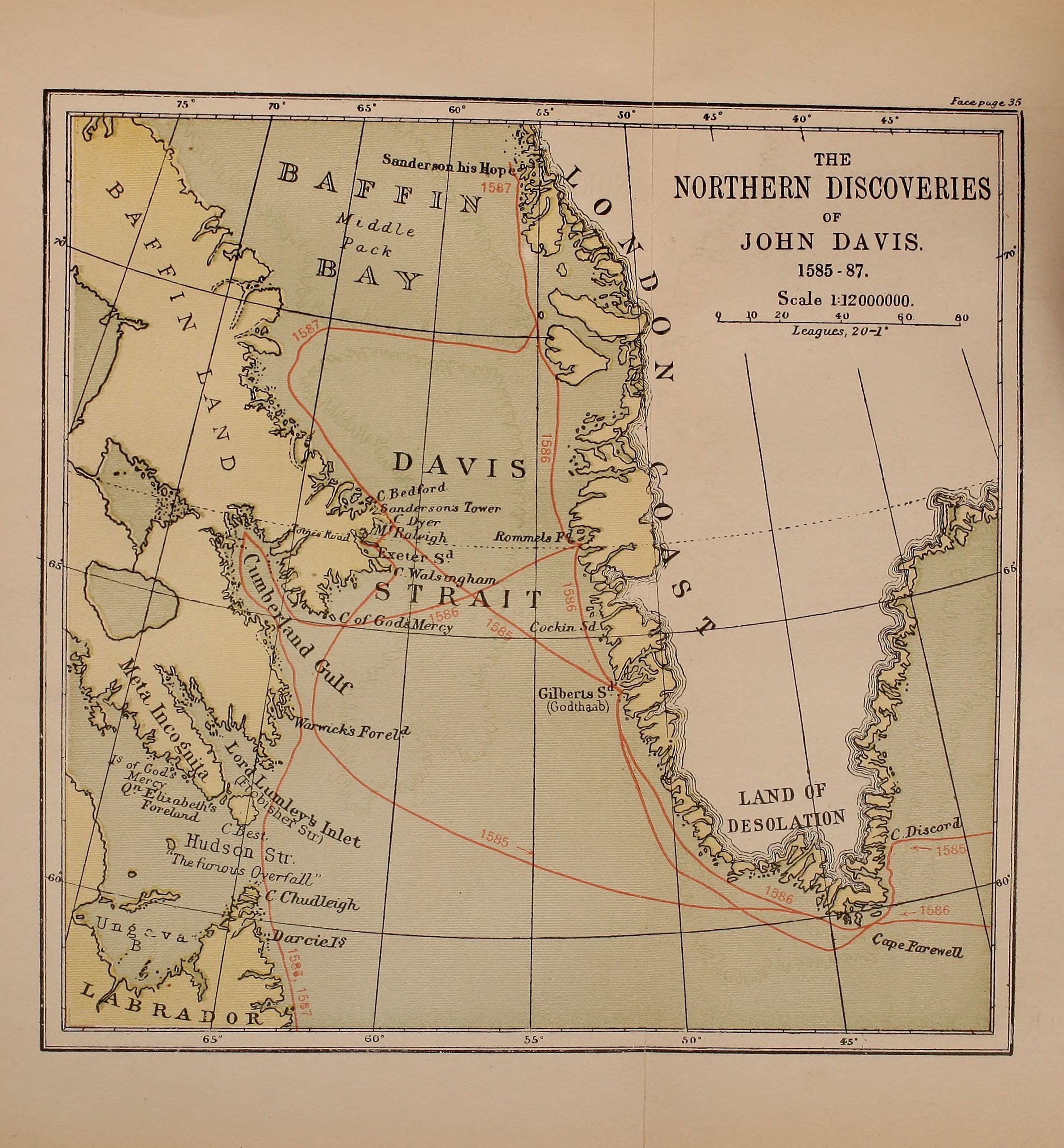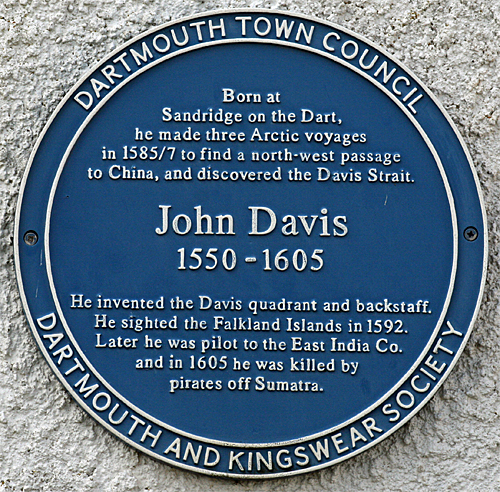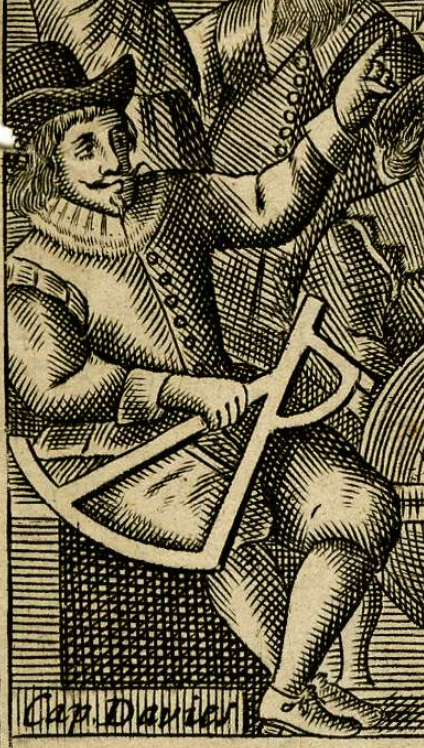1. Early Life and Background

John Davis was born around 1550 in Stoke Gabriel, Devon, England, and spent his childhood in nearby Sandridge Barton. Records indicate he was baptized in Stoke Gabriel in October 1550. It is suggested that he developed his seamanship skills at an early age, playing with boats along the River Dart. His formative years were influenced by his close relationships with notable neighbors, including Adrian Gilbert, Humphrey Gilbert, and their half-brother Walter Raleigh. From an early stage, he also formed a friendship with the influential scholar John Dee.
2. Expeditions and Discoveries
Throughout his career, John Davis undertook numerous significant voyages and explorations, greatly contributing to geographical knowledge and discovery. His expeditions primarily focused on the search for the Northwest Passage and extended to naval conflicts and distant trade routes.
2.1. Northwest Passage Expeditions
Davis's primary objective was the search for a navigable Northwest Passage, a sea route connecting the Atlantic Ocean and the Pacific Ocean through the Arctic Archipelago. He made several concerted efforts to find this elusive passage, leading to significant geographical findings in the Arctic regions.
2.1.1. 1585 Voyage
In January 1583, Davis presented his idea for a Northwest Passage voyage to Francis Walsingham, Queen Elizabeth I's secretary, and to John Dee. Two years later, in 1585, Walsingham provided funding for Davis's first major expedition to the Arctic. Following a route similar to Frobisher's, Davis's expedition traced Greenland's east coast, rounded Cape Farewell (Greenland's southern tip), and then sailed west towards Baffin Island. During this voyage, he discovered the strait that would later be named the Davis Strait, located between Greenland and Baffin Island. Initially, Davis adopted an amiable approach to the Inuit people, bringing musicians and encouraging his crew to dance and play with them to establish friendly relations.
2.1.2. 1586 and 1587 Voyages

Davis continued his quest for the Northwest Passage with subsequent voyages in 1586 and 1587. In 1586, he returned to the Arctic with four ships; two were sent to Greenland's iceberg-calving eastern shore, while the other two penetrated the Davis Strait as far as 67°N before being blocked by the Arctic ice cap. One of his ships, Sunshine, attempted unsuccessfully to circumnavigate Greenland from the east. During these voyages, the initially friendly interactions with the Inuit changed after they stole one of his anchors; they were possibly angered by being interrupted during a religious ceremony. Inuit also attacked his ships in Hamilton Inlet in Labrador.
His third expedition in 1587 saw him pass through the Davis Strait into Baffin Bay, sailing north along Greenland's west coast to reach 72°N (south of present-day Upernavik) and Disko Island before unfavorable winds forced him back. On his return, Davis charted Davis Inlet on the coast of Labrador. The logbook from this trip became a textbook model for subsequent captains for centuries. Davis named several places in the Arctic, including Cumberland Sound, Cape Walsingham, and Exeter Sound on Baffin Island. Despite his extensive explorations, Davis, like Martin Frobisher, was unable to navigate through the "Furious Overfall," a strong current in the Hudson Strait, and thus did not discover Hudson Bay.
2.2. Other Voyages and Activities
Beyond his primary quest for the Northwest Passage, Davis participated in significant maritime engagements, including naval conflicts and voyages to distant regions, expanding his influence and experience.
2.2.1. Spanish Armada Service
In 1588, John Davis appears to have commanded the ship Black Dog during the English defense against the Spanish Armada. His involvement contributed to England's successful repulsion of the Spanish invasion fleet. In 1589, he joined the Earl of Cumberland as part of the Azores Voyage of 1589.
2.2.2. Voyage with Cavendish and Falkland Islands Discovery
In 1591, Davis accompanied Thomas Cavendish on Cavendish's second and final voyage. The expedition aimed to discover the Northwest Passage from the Pacific side, by sailing around South America. After Cavendish's death in the South Atlantic due to an engagement with Portuguese forces in Brazil and subsequent illness, Davis took command of the remaining ships and attempted to navigate the Strait of Magellan. Although thwarted by severe weather, he made a significant discovery in August 1592, sighting the Falkland Islands aboard his ship, Desire. His crew was forced to hunt hundreds of penguins for food on the islands, but the stored meat spoiled in the tropics. Consequently, only 14 of his 76 men survived the arduous journey back to England, suffering from starvation.
2.2.3. East Indies Voyages
From 1596 to 1597, Davis sailed with Walter Raleigh as the master of Raleigh's ship on voyages to Cádiz and the Azores. From 1598 to 1600, he accompanied a Dutch expedition to the East Indies as a pilot, sailing from Flushing and returning to Middelburg. During this time, he meticulously charted and recorded geographical details of the region. He narrowly escaped a treacherous attack at Aceh on Sumatra.
From 1601 to 1603, he served as Pilot-Major on the first voyage of the English East India Company, accompanying Sir James Lancaster. For his role, Davis was promised a substantial payment: 500 GBP if the voyage doubled its initial investment, 1.00 K GBP if it tripled, 1.50 K GBP if it quadrupled, and 2.00 K GBP if it quintupled. Before departure, Davis had informed London merchants that pepper could be acquired in Aceh for four reals of eight per hundredweight, but the actual cost was 20 reals. Upon the voyage's return, Lancaster criticized Davis for his inaccurate information regarding both the price and availability of pepper.
Feeling unfairly blamed, Davis set sail again for the East Indies on 5 December 1604, serving as pilot to Sir Edward Michelborne. Michelborne was an "interloper" who had been granted a charter by James I, despite the East India Company's supposed monopoly on trade with the East.
4. Personal Life and Controversies
Aspects of John Davis's private life included his marriage and family, as well as notable personal entanglements and public controversies.
4.1. Marriage and Family
On 29 September 1582, John Davis married Faith Fulford, the daughter of Sir John Fulford, who was the High Sheriff of Devon, and Dorothy Bourchier, daughter of the Earl of Bath. They had four sons and one daughter. Upon his return from the 1592 voyage, Davis discovered that his wife had become involved with another man, described as a "sleek paramour." Conspiring with this man, who was a counterfeiter, Faith brought "false and unavailing charges" against Davis.
4.2. Involvement in Plots
Davis was also involved in a plot to entrap Thomas Aufield, a Catholic priest. Likely acting as an agent provocateur under the direction of his patron, Francis Walsingham, Davis claimed to have converted to Catholicism. He offered to hand over several English ships to the Pope or to Spain to aid the Catholic cause. He met Aufield in Rouen to discuss this proposal, but negotiations failed. Davis then returned to England, where Aufield was subsequently arrested for circulating Catholic texts. Aufield was tortured and found guilty of distributing a book that criticized the queen's religion. He was hanged on 6 July 1585 at Tyburn.
5. Death
John Davis met his demise on 29 December 1605, off Bintan Island near Singapore, in the Strait of Malacca. He was killed by a group of what were described as "Japanese pirates" whose disabled vessel he had just seized. The pirates had engaged in several days of seemingly friendly discourse with the English before launching a surprise attack. During this attack, Davis was "dragged back, hacked and slashed, and thrust out again," dying almost immediately.
6. Legacy and Historical Assessment
John Davis left a significant legacy in the fields of exploration, geography, and navigation. His life and work are remembered through geographical recognition and critical evaluations of his achievements and interactions.
6.1. Naming and Geographical Recognition

Several geographical features bear John Davis's name, most notably the Davis Strait, the sea lane between Greenland and Baffin Island that he extensively explored. Other features include Davis Inlet on the coast of Labrador. In the centuries following his death, the importance of Dutch whalers led to the settlements along Greenland's western coast being referred to as "Straat Davis," reflecting their name for the strait. This also led to the name "Greenland" being erroneously applied to the eastern shore, which was presumed to be the site of the Norse Eastern Settlement.
6.2. Critical Evaluation
Davis's achievements as an explorer and navigator are widely recognized. He is considered one of the great early Arctic explorers, alongside figures like William Baffin and Henry Hudson. His detailed logbooks and charts served as models for future expeditions. However, his interactions with indigenous peoples, such as the Inuit, were not always peaceful, evolving from initial friendly encounters to conflict, including theft and attacks, which may have been provoked by misunderstandings or perceived interruptions of their ceremonies. His contributions to navigation through his inventions, like the Davis quadrant, and his published works, The Seaman's Secrets and The World's Hydrographical Description, significantly advanced maritime practices and knowledge, influencing seamen for generations. His involvement in the plot against Thomas Aufield also highlights a controversial aspect of his life, demonstrating his role as an agent for powerful patrons in the political and religious conflicts of the Elizabethan era.
